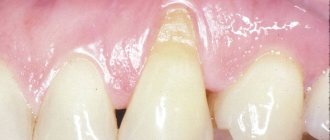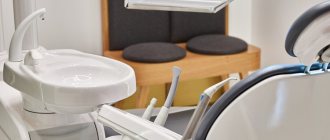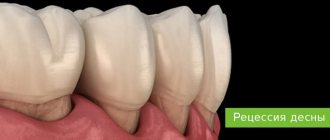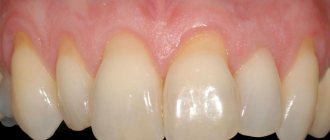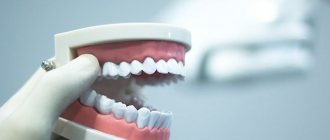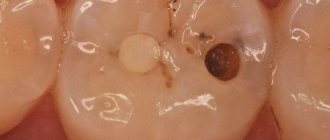Every person has had an inflamed gum at least once in their life. This usually occurs due to brushing too aggressively, using a hard toothbrush, putting too much pressure on the soft tissue of the floss, or eating very hard foods. If the causative factor is eliminated, the gums quickly heal and the inflammation goes away. But there are situations when the gums near the crown of the tooth become inflamed, but there were no obvious reasons provoking this condition. In this case, you need the help of a dentist.
Causes of bleeding gums
If you notice your gums are bleeding, before you panic, first consider whether you might:
- mechanically damage the interdental spaces when using floss (dental floss). In this case, it is worth treating the oral cavity with an antiseptic solution of chlorhexidine 2-3 times a day, rinsing with calendula decoction
- replace a regular toothbrush with an electric one. Bleeding is normal the first few times you use an electric toothbrush. This usually goes away completely within 2-3 days. If not, contact your dentist, start rinsing with an antiseptic, and stop using the power brush until you receive further instructions from your doctor.
- Using an oral irrigator incorrectly. Often new owners of such an indispensable device as an irrigator immediately begin to treat the oral cavity with a high-pressure stream of water instead of allowing the tissues to adapt. In this case, it is worth temporarily filling the irrigator container with chlorhexidine, either pure or mixed with water, and cleaning at the minimum power level. Typically, symptoms should completely disappear within a couple of days.
Also, bleeding gums are not a rare occurrence in pregnant women as a result of powerful hormonal changes. During this period, you need to treat your teeth with increased attention and care.
None of the above? Then there is a high probability of an inflammatory process in the tissues. In the early stages, you may notice slight bleeding and slight swelling - signs of gingivitis. Ignoring the symptoms can lead to the development of pain and the onset of suppuration, which will indicate the transition of the disease to a dangerous stage of periodontitis.
If your teeth bleed when brushing
Bleeding gums occur due to gingivitis. In itself, it does not cause major problems, but it is the first symptom of the development of such a serious disease as periodontal disease. Bleeding primarily occurs when brushing your teeth or when you have to bite something hard. It is better to deal with this symptom as early as possible, before the next stage of the disease appears - exposure of the necks of the teeth.
How does the situation develop if nothing is done?
At first, when brushing your teeth, a little blood comes out of your gums. This usually begins after gum swelling has appeared. This is the stage of gingivitis. After some time, pain, loosening of the teeth and exposure of their necks appear. A full range of symptoms of periodontitis occurs. This already causes anxiety for the patient. In the absence of adequate treatment, the final stage occurs - periodontal disease. This disease leads to complete loss of teeth
How to treat bleeding gums?
The only treatment method is to remove tartar and plaque. It is best to start by ordering a professional ultrasound tartar removal procedure from your dentist. Then you need to purchase the softest and fluffiest toothbrush possible and thoroughly brush your teeth with it in the morning and evening for at least three minutes. Instead of tooth powder, it is better to use ash and rinse your mouth with hot water - you will immediately notice how much more effectively your teeth are cleaned with this method.
Treating bleeding gums at home
- First of all, it is necessary to remove tartar. For this purpose, use grated black radish with lemon juice, chew it thoroughly and brush your teeth with it for at least 3 minutes every evening. The second most effective remedy is a decoction of walnut bark - pour 2 tablespoons of dry bark into a glass of cold water, bring to a boil and boil for 15 minutes. You also need to brush your teeth and rinse your mouth for at least 5 minutes every evening.
- The second stage is removing inflammation from the gums. A decoction of sage or oak bark works best here. Two tablespoons of sage or 2 teaspoons of bark per glass of boiling water. Boil in a water bath for 10 minutes. Rinse your mouth every four hours if possible. It should be borne in mind that oak bark somewhat darkens the color of the teeth.
- For internal prevention of the disease, you need to eat at least 400 g of cottage cheese per week and every day - something with vitamin C (kiwi, a cup of rosehip decoction with sugar, lemon, black currant, etc.).
Prevention
According to US standards, you need to have professional ultrasonic cleaning of teeth to remove tartar at least three times a year. This is mandatory, but it should be borne in mind that such cleaning is not a panacea, since if you do not brush your teeth, the stone will form again within a week. Therefore, you need to thoroughly brush your teeth twice a day with a soft toothbrush, so that it is not scary to press it hard. It is better to use ash instead of powder and rinse your mouth with hot water. After cleansing, you can use one of the following: chew a slice of fresh ginger, rinse your mouth with a homemade lactic acid product, gargle with sage, or chew grated radish. It is better to alternate the product used from time to time.
Methods for treating bleeding gums
The treatment that's right for you depends on the cause of your symptoms.
As we have already mentioned, if you notice bleeding as a result of careless manipulations with floss when performing oral hygiene, changed your toothbrush, started using an irrigator, or are pregnant, you can fix the problem yourself. It is enough to rinse with antiseptic compounds and temporarily reduce the load.
In case of gingivitis, you should contact your dentist as soon as possible. The doctor will examine your teeth for tartar and plaque. Perhaps the problem will be solved after professional cleaning and removal of unwanted deposits in which bacteria multiply. Additionally, local anti-inflammatory drugs (Metrogil Denta, Cholisal) and chlorhexidine rinses may be prescribed.
If the gums are very inflamed and painful, more radical actions may be required:
- Surgical cleaning of periodontal pockets. This technique is called “curettage” and provides a closed type of treatment (without cutting the gums) if the pockets are not deep and an open one (with cutting the gums) if the closed one does not produce results.
- Gum plastic surgery. The procedure is used in advanced, especially severe cases of periodontitis. The doctor either removes excess tissue or, on the contrary, builds up the gum. The operation is low-traumatic and quite effective, especially in combination with treatment with anti-inflammatory drugs and (if necessary) antibiotics
Causes
The most common factors that lead to bleeding gums are:
- Improper oral hygiene:
using a brush with hard bristles, strong pressure when brushing, inaccurate use of dental floss, picking with toothpicks and other objects, improper installation of dentures. Due to frequent trauma, gum pockets form, which provoke inflammation.
- Tartar.
With irregular and improper brushing of teeth, plaque forms, which gradually hardens. The stone moves the gum away from the tooth, the tissue becomes inflamed and begins to bleed.
- Dental procedures.
Bleeding may occur after professional cleaning, tooth extraction, or the installation of a filling or implant. A poorly manufactured or fitted structure constantly injures the edge of the gum. In addition, filling material and dentures can cause an allergic reaction.
- Diseases of gums and teeth:
gingivitis, periodontitis, periodontal disease. Inflammatory processes are accompanied by swelling, swelling, exposure of the neck, abrasion and loosening of teeth.
- Infections and viruses.
Herpes, fungus, tonsillitis, influenza, ARVI, tuberculosis, HIV lead to the destruction of the periodontal structure and provoke inflammatory processes in the oral cavity.
- Hypovitaminosis.
Bleeding from the gums occurs when there is a deficiency of vitamins B, K, C, E. A monotonous and unbalanced diet, frequent diets, and inducing vomiting lead to pathology. With a lack of vitamin C, scurvy can develop. During the disease, teeth become loose and begin to fall out.
- Hormonal disbalance.
The problem is observed during pregnancy and puberty, with diabetes. Due to an imbalance of biologically active substances, tissues swell and become looser. In this case, bleeding from the gums occurs not only when brushing teeth and eating solid food, but also from the slightest touch.
- Taking a number of medications.
Blood thinners, including Aspirin, Heparin, and Warfarin, can lead to the problem. Some nonsteroidal anti-inflammatory drugs have similar side effects.
- Blood diseases.
Bleeding disorders often lead to gum pathology: hemophilia, thrombocytopenia. The condition of the mucous membranes also worsens with tumor processes - leukemia and leukemia.
conclusions
Carefully monitor the health of your teeth and oral cavity. Use dental floss and irrigator carefully. In case of gum swelling, pain and bleeding, it is better to immediately seek professional help. This will allow you to stop the problem in a timely manner and prevent it from developing into periodontitis.
Don't neglect professional teeth cleaning. Remove tartar and plaque at least once a year. More often if you have dentures, implants and/or smoke.
Strictly follow your doctor's instructions, especially with regard to taking antibiotics and using medicinal ointments and solutions.
Treatment methods
If you find that there is bleeding from your gums, you should immediately contact your dentist. The doctor will determine the cause and prescribe adequate treatment. The most effective ways to combat bleeding gums are:
- Professional teeth cleaning and ultrasonic calculus removal.
Waves completely eliminate plaque. During pregnancy, methods that are safe for the fetus are used.
- Rinse with antiseptics.
Chlorhexidine, Miramistin, Rotokan, Chlorphyllipt, Furacilin, Tantum Verde, etc. are prescribed as a solution for sanitation. It is acceptable to use decoctions of sage, chamomile, calendula, and oak bark. The procedure is carried out in the morning, before bed and after each meal. The course lasts no more than 10 days.
- Dental gels and ointments.
The most effective drugs are Metrogyl Denta, Asepta, Dental, Cholisal, Parodium, Stomatofit, Solcoseryl, Salvin. The composition quickly penetrates the mucous membrane, has an antimicrobial effect, relieves inflammation, pain and bleeding. The products are applied twice a day, after rinsing and drying with a cotton swab.
- Additional medications.
For concomitant diseases of the oral cavity, antibiotics, painkillers, “Parodontocid” spray, lozenges Septolete, Faringosept, Grammidin, etc. are prescribed.
- Physiotherapy.
Gum restoration is accelerated by procedures such as ultraviolet irradiation, electrophoresis, current treatment, oxygen treatment, balneo-, light- and vacuum therapy. Various types of massage are effective: water, hardware, manual. As a rule, a course of physiotherapy includes 5 procedures.
- Proper oral care.
It is necessary to brush your teeth twice a day. Dentists recommend using only soft brushes marked Soft and pastes for bleeding gums: Parodontax, Lacalut, ROCS, BlanX, Mexidol Dent. After eating, you need to carefully remove food debris with dental floss and use an alcohol-free mouth rinse: Silca, Lacalut, PresiDent, Forest Balm. You can also use a solution of water with salt or hydrogen peroxide.
- Taking vitamin complexes and immunomodulators.
Popular drugs are “Dentovitus”, “Alphabet”, “Vitrum”, “Immunal”, “Calcinova”, “Calcium D3 Nycomed”, and lemongrass tincture. To reduce the fragility of capillaries, Ascorutin is additionally prescribed.
- Nutrition correction.
It is recommended to avoid sugar, bread, spicy, sour and salty foods, carbonated drinks and alcohol. The diet should include fresh juices, vegetables and fruits, foods rich in protein, vitamins C, B, K, E. As a result, periodontal tissue will be strengthened, and the mucous membranes will recover faster. Spices are also useful: ginger, wasabi, sesame, cinnamon. Spices stop the proliferation of bacteria and relieve inflammation.
There are also emergency measures. If there is bleeding from the gums, it is necessary to apply a swab soaked in ice water to the tissue. This will quickly soothe the gums and stop bleeding.
The best treatment is prevention. Visit your dentist twice a year. A specialist will detect and eliminate all problems with teeth and gums in a timely manner. If you follow your doctor's recommendations, you will forever forget about bleeding gums.
This article is for informational purposes only, please consult your doctor for details! Ask your doctor about contraindications and side effects.
Content
- Causes of bleeding
- Possible complications
- Treatment regimens
- Prevention
If your tooth is bleeding, gum disease may be the cause. Inflammatory processes develop as a result of gingivitis and periodontitis, in the absence of proper oral hygiene. If there is pathology, bleeding can be caused even by regular brushing of teeth.
To fix a problem, you need to understand the cause of its occurrence. In some cases, it will be enough to eliminate the source of the problem; sometimes the approach to treatment should be complex, using medications.
PROMOTION
Dental restoration, installation of fillings
from 2200 rub.



